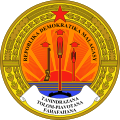
Back República Democrática de Madagascar AST República Democrática de Madagascar Spanish République démocratique malgache French Jamhuriyar Demokradiyyar Madagascar Hausa Republik Demokratik Madagaskar ID Repubblica Democratica Malgascia Italian マダガスカル民主共和国 Japanese ສາທາລະນະລັດປະຊາທິປະໄຕ ມາດາກັສກາ Laothian Repoblika Demôkratika Malagasy Malagasy Democratische Republiek Madagaskar Dutch
This article needs additional citations for verification. (November 2023) |
Democratic Republic of Madagascar | |||||||||
|---|---|---|---|---|---|---|---|---|---|
| 1975–1992 | |||||||||
Motto:
| |||||||||
| Anthem: Ry Tanindrazanay malala ô! (Malagasy) Ô Terre de nos ancêtres bien-aimés! (French) "Oh, land of our beloved ancestors!" | |||||||||
 Location of the Democratic Republic of Madagascar in Africa | |||||||||
| Capital | Antananarivo | ||||||||
| Common languages | |||||||||
| Government | Unitary Marxist–Leninist state[2][3] under a military regime[4] | ||||||||
| President | |||||||||
• 1975–1992 | Didier Ratsiraka | ||||||||
| Prime Minister | |||||||||
• 1976 | Joel Rakotomalala | ||||||||
• 1991–1992 | Guy Razanamasy | ||||||||
| Legislature | Popular National Assembly | ||||||||
| Historical era | Cold War | ||||||||
• Established | 30 December 1975 | ||||||||
| 12 January 1992 | |||||||||
| Area | |||||||||
| 1975[5] | 587,040 km2 (226,660 sq mi) | ||||||||
| 1992[6] | 587,040 km2 (226,660 sq mi) | ||||||||
| Population | |||||||||
• 1975[5] | 7,568,577 | ||||||||
• 1992[6] | 12,596,263 | ||||||||
| Currency | Malagasy franc (MGF) | ||||||||
| Calling code | 261 | ||||||||
| ISO 3166 code | MG | ||||||||
| |||||||||
| Today part of | Madagascar | ||||||||
| History of Madagascar |
|---|
 |
|
The Democratic Republic of Madagascar (Malagasy: Repoblika Demokratika Malagasy, French: République démocratique de Madagascar) was a socialist state that existed on the island of Madagascar from 1975 to 1992.
- ^ Le Comité Consultatif Constitutionnel (1 October 2010). "Projet de Constitution de la Quatrième République de Madagascar" (PDF) (in French). Madagascar Tribune. Archived (PDF) from the original on 28 June 2011. Retrieved 24 August 2011.
- ^ "The Second Republic". Britannica. Retrieved 19 May 2025.
- ^ "AFRICAN MARXIST MILITARY REGIMES, RISE AND FALL: INTERNAL CONDITIONERS AND INTERNATIONAL DIMENSIONS". Brazilian Journal of African Studies. 2020. Retrieved 10 February 2025.
…Military Coups of a new type, which introduced revolutionary regimes self-declared Marxist-Leninist. This is the case of Somalia (1969) and Ethiopia (1974), the most emblematic case, but also of four french-speaking countries: Congo-Brazzaville (1968), Daomey/Benin (1972-74), Madagascar (1975) and Alto Volta/Burkina Faso (1983).
- ^ "AFRICAN MARXIST MILITARY REGIMES, RISE AND FALL: INTERNAL CONDITIONERS AND INTERNATIONAL DIMENSIONS". Brazilian Journal of African Studies. 2020. Retrieved 5 March 2025.
In contrast to Angola and Mozambique, where the Marxist component was associated with National Liberation Movements, those in Ethiopia and Somalia, as well as the four Francophone States, had Marxist Military Revolutions/Regimes after more than a decade of independence.
- ^ International Demographic Data Center (U.S.), United States Bureau of the Census (1980). World Population 1979: Recent Demographic Estimates for the Countries and Regions of the World. The Bureau. pp. 102–103.
- ^ The World Factbook 1992

